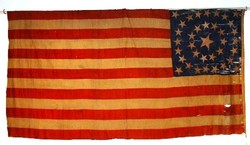

Reverse - edit 1
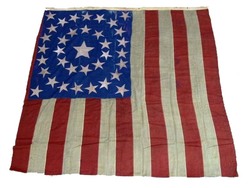
Obverse - edit
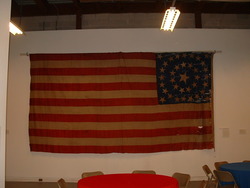
Reverse - 1
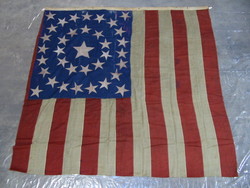
OBVERSE 1
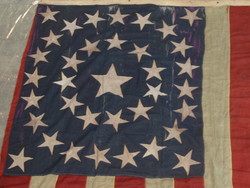
CANTON
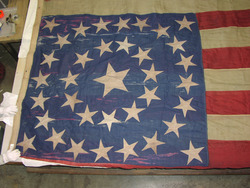
Canton
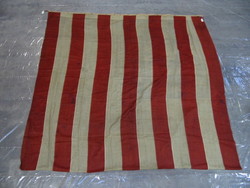
REVERSE 1
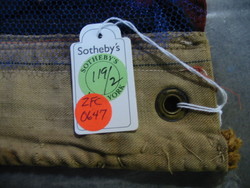
DETAIL
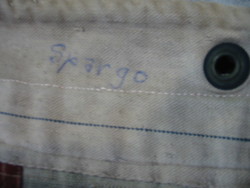
DETAIL

DETAIL
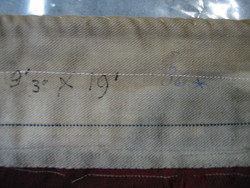
DETAIL

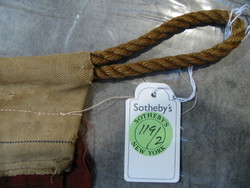
DETAIL
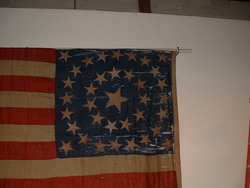
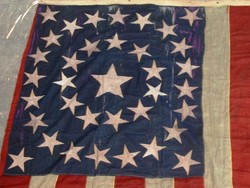
Canton - edit
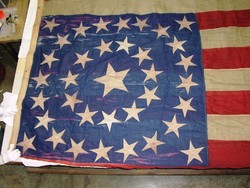
Canton - edit 2
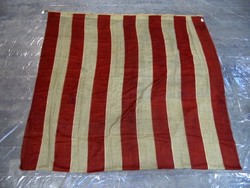
Reverse - edit
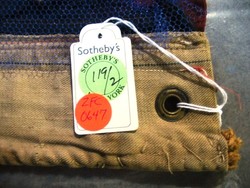
info - edit
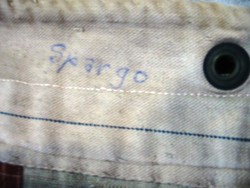
Detail - Edit
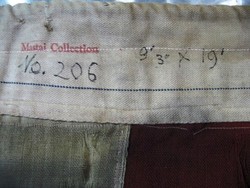
Detail - Edit 2
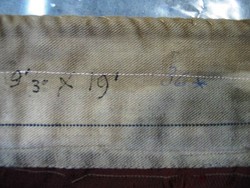
Detail - edit 3
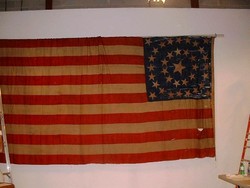
Reverse - edit 2
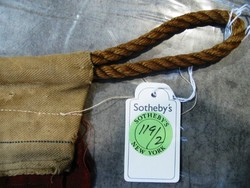
Detail - edit 5
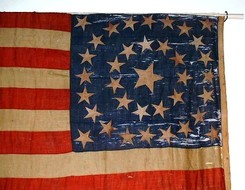
Reverse - edit 3
U.S. 36 Star Flag - John Spargo
Sub-collection: Mastai - Early American Flags36-Star U.S. Flag, Double Ring Star Pattern: A John Spargo Flag.
John Spargo, the Director of the Bennington Museum in Vermont, previously owned this striking flag. Author, educator, historian and progressive socialist, Spargo wrote about and collected variants of Old Glory.
Americans have been enormously inventive in the designs they have created for the star field of the national flag, such as this double ring pattern which features a large central star. In the 19th century individuals and manufacturers were free to create their own designs for the stars on the flag. The fly end was formerly folded back on itself and hemmed to the header, possibly to facilitate display.
While the arrangement of stars in the United States flag in a ring or a circle around a central star dates possibly as early as the later years of the Revolution (and definitely to the 1790s) the concept of multiple concentric rings surrounding a center star first appears during the War with Mexico (1846 1848). The concept became more popular in the Middle Atlantic states of New Jersey, Pennsylvania, and Maryland during the Civil War, where the center star and inner ring was to represent the original thirteen states, and the outer ring more recent additions to the Union, all equal and united in perpetuity. Some of the manufacturers of these concentric ring star patterns are well known, including Horstmann Brothers & Co. of Philadelphia, Evans & Hassall of Philadelphia, and Jabez Loane of Baltimore.
These makers produced flags with all the stars equal in size. Another maker (possibly William Yard), thought to have been employed in New Jersey, may have made similar flags but with the central star larger than those in the surrounding rings. 34 and 38 star variations of this star pattern are known to survive. This flag also bears the name Spargo inked onto its heading, a reference to the flag historian and previous owner, John Spargo.
Exhibition History:
Baltimore Star Spangled Banner Flag House 3/2004
(ZFC0647)
Presidential Debate, Washington University at St. Louis, October, 2004
(ZFC0647)
Provenance: Acquired by the Zaricor Flag Collection in 2002 from the Mastai Collection through auction at Sothebys, New York, New York.
ZFC Significant Flag
Provenance:
• John Spargo, Bennington, VT.
• Acquired by Mr. & Mrs. Boleslaw & Marie-Louise D'Otrange Mastai, New York City, and Amagansett, NY, The Mastai Collection, until 2002.
• Sold via Sotheby's Auction in New York City to the Zaricor Flag Collection, 2002.
Sources:
Madaus, Howard M.- Whitney Smith, The American Flag: Two Centuries of Concord and Conflict, VZ Publications, Santa Cruz, 2006.
Mastai, Boleslaw and Marie-Louise D'Otrange, The Stars and The Stripes: The American Flag as Art and as History from the Birth of the republic to the Present, Knopf, New York, 1973.
John Spargo, Wikipedia, 11 November 2011, from:
http://en.wikipedia.org/wiki/John_Spargo
Crawford, Amanda J, "Today's tent king sewed sails in 1815", History: Loane Bros. Inc. has survived 184 years by making frequent adaptations, whether they be in making sails, Civil War military tents, or possibly the nation's first awnings, Loane Brothers Inc. , 11 November 2011, from: http://www.loanebros.com/about.htm
John Spargo, Spartacus Educational, 11 November 2011, from: http://www.spartacus.schoolnet.co.uk/USAspargo.htm
Image Credits:
Zaricor Flag Collection
Hoist & Fly | |
|---|---|
| Width of Hoist | 112 |
| Length of Fly | 219 |
Union/Canton | |
|---|---|
| Width of Union/Canton | 59.5 |
| Length of Union/Canton | 65.5 |
Stars | |
|---|---|
| Comments on Star Measurements | Size of stars varies, center star is 14". Star pattern is 1 in the center, surrounded by 11, 20 with one in each corner. The large center star is oriented with one point towards the hoist. |
| Size of Stars | 8 |
Stripes | |
|---|---|
| Width of 1st Stripe | 9 |
| Width of 3rd Stripe | 9 |
| Width of 8th Stripe | 9 |
| Width of Last Stripe | 9 |
| Size of Hoist | 2.75 |
Frame | |
|---|---|
| Is it framed? | no |
Stars | |
|---|---|
| Number of Stars | 36 |
| How are the stars embeded? | Applique |
| Are there stars on obverse? | yes |
| Are there stars on reverse? | yes |
Stripes | |
|---|---|
| Number of Stripes | 13 |
| Color of Top Stripe | Red |
| Color of Bottom Stripe | Red |
| Has a Blood Stripe? | no |
Nationality | |
|---|---|
| Nation Represented | United States |
Fabric | |
|---|---|
| Fabric | Wool |
| Comments on Fabric | Star field has been netted. Bunting |
Stitching | |
|---|---|
| Stitching | Combination |
| Comments on Stitching | Stars are hand stitched while the stripes are machine stitched |
Weave | |
|---|---|
| Type of Weave | Plain |
Attachment | |
|---|---|
| Comments on Method of Attachmen | Also rope in sleeve, one loop has been cut and the flag has grommetts added. The flag also bears tack marks. |
| Method of Attachment | Roped-header |
Applica | |
|---|---|
| Applique Sides | Single Faced = Mirror Image Reverse |
Condition | |
|---|---|
| Condition | Fair |
| Damage | Used, soiled, stained, canton is separating as fabric ages. Attempted repairs & netting. Flag is folded over back upon itself, perhaps it facilitates display. Trending to good |
| Displayable | yes |
Date | |
|---|---|
| Date | 1864-1867 |
Exhibits | |
|---|---|
| Exhibition Copy | Baltimore Star Spangled Banner Flag House 3/2004 (ZFC0647) 36-Star United States Flag, Double Ring Star Pattern Date: 18651867 (Nevada was admitted to statehood on October 31, 1864) Media: Wool bunting field and canton with cotton stars, all hand sewn. Size: 112" on the hoist by 219" on the fly (9.5' by 18.3') Comment: While the arranging of the stars in the United States flag in a ring or a circle around a center star dates possibly to as early as the later years of the Revolution, and definitely to the 1790s, the concept of multiple concentric rings surrounding a center star first appears during the War with Mexico (1846 1848). The concept became more popular in the Middle Atlantic states of New Jersey, Pennsylvania, and Maryland during the Civil War, where the center star and inner ring was to represent the original thirteen states, and the outer ring more recent additions to the Union, all equal and united in perpetuity. Some of the manufacturers of these concentric ring star patterns are well known, including Horstmann Brothers & Co. of Philadelphia, Evans & Hassall of Philadelphia, and Jabez Loane of Baltimore. These makers produced flags with all the stars equal in size. Another maker (possibly William Yard), thought to have been employed in New Jersey, may have made similar flags but with the central star larger than those in the surrounding rings. 34 and 38 star variations of this star pattern are known to survive. This flag also bears the name Spargo inked onto its heading, possibly a reference to flag historian John Spargo. Unfortunately confirmation is lacking. Provenance: Acquired by the Zaricor Flag Collection in 2002 from the Mastai Collection through auction at Sotheby's, New York, New York. American Maritime Flags of the 19th Century Ships and coastal installations (both governmental and private) require flags that can be identified from great distances. Recognition was achieved during the nineteenth century by providing these vessels and facilities with flags that were especially large. Exhibited here are several American flags related to such vessels or facilities from the period 1818 to 1893. They are all large bunting flags. Generally speaking, a large flag is one that is too unwieldy to be carried by one person if the flag is attached to a staff meant to be carried by single individual. Until 1854 in the British Army, and until 1895 in the American Army, military colors carried by units on foot were made of silk and measured no more than 6 feet on the staff by 6 feet 6 inches on the fly. Those dimensionsessentially a flag with an area encompassing slightly more than four square yards of clothwere deemed the maximum size for transport by an individual on a staff. Most of the flags in this exhibit exceed those parameters. Due to their size, large flags such as these are difficult to display and are seldom sought by collectors. Museums often relegate them to perpetual storage. This exhibit is unusual, therefore, in that it displays so many of these flags in one place. This exhibit is sponsored by the Veninga-Zaricor family and Good Earth Teas, Santa Cruz, CA; The Flag Center, Presidio of San Francisco, CA; and the Star-Spangled Banner Flag House, Baltimore, MD. Presidential Debate Washington University at St. Louis October 2004 (ZFC0647) 36-Star United States Flag John Spargos Flag One of the First Historians of the U.S. Flag (18611863) John Spargo, the Director of the Bennington Museum in Vermont, previously owned this striking flag. Author, educator, historian and progressive socialist, Spargo wrote about and collected variants of Old Glory. Americans have been enormously inventive in the designs they have created for the star field of the national flag, such as this double ring pattern which features a large central star. In the 19th century individuals and manufacturers were free to create their own designs for the stars on the flag. |
| Exhibition Images | |





















